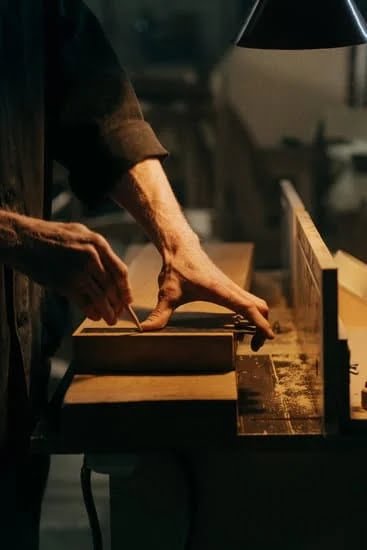Are you wondering how to strip woodwork before refinishing or repainting? Stripping woodwork is an essential process to ensure a smooth and professional-looking finish. Whether you want to restore an old piece of furniture or give a fresh look to your interior trim, understanding the stripping process is crucial. In this article, we will discuss the importance of stripping woodwork and why it’s necessary before refinishing or repainting.
Before diving into the stripping process, it’s important to understand the different types of woodwork and how the stripping process may vary depending on the type of wood. Additionally, we will cover the essential tools and equipment needed for stripping woodwork, including safety gear to ensure a safe working environment.
In addition to that, we will also provide a step-by-step guide on how to strip woodwork using different methods such as chemical stripping, heat gun stripping, and sanding. Lastly, we will share expert tips and tricks for a successful wood stripping process, as well as the importance of proper aftercare for the stripped woodwork. By the end of this article, you will have all the knowledge you need to confidently strip woodwork before refinishing or repainting it.
Understanding the Wood
When it comes to stripping woodwork, it’s crucial to understand the type of wood you are working with and how the stripping process may vary depending on the specific characteristics of that wood. Different types of woodwork, such as oak, pine, cherry, or mahogany, have unique qualities that can affect how they respond to stripping methods. Understanding these differences will help you choose the right approach for effectively removing old finishes or paint from your woodwork.
Types of Woodwork
Woodwork can be categorized into hardwood and softwood. Hardwood includes woods like oak, cherry, and mahogany, which are known for their durability and strength. On the other hand, softwood includes woods like pine and cedar, which are more porous and less dense than hardwood. Each type of wood requires a different approach to stripping due to variations in density and hardness.
Varying Stripping Methods
The method used for stripping woodwork can vary based on the type of wood involved. For example, softwoods may be more susceptible to damage from harsh chemical strippers compared to hardwoods. Similarly, using a heat gun on certain types of hardwood may require extra care due to their density. Understanding these nuances is essential for a successful wood stripping process.
Considerations for Different Woods
In addition to density and porosity, different woods may have unique grain patterns or natural oils that impact how they respond to stripping. For instance, certain types of exotic woods have natural oils that make them resistant to traditional chemical strippers.
In such cases, alternative methods like sanding or heat gun stripping may be more effective. Taking the time to understand the specific characteristics of the woodwork you are dealing with will ensure that you choose the best approach for safe and effective stripping.
Whether it’s oak trim in need of a refresh or a pine cabinet begging for an update, understanding how different types of woodwork require tailored stripping methods is essential for achieving professional results.
Tools and Equipment Needed
When it comes to stripping woodwork, having the right tools and equipment is crucial for a successful and safe process. Before beginning any wood stripping project, it’s important to gather all the necessary items to ensure that the job is completed efficiently. Additionally, safety gear is essential to protect yourself from any potential hazards during the wood stripping process.
Essential Tools
The essential tools needed for stripping woodwork include chemical strippers, heat gun, sandpaper, paint scraper, putty knife, and a soft-bristle brush. Chemical strippers are effective in removing old finishes and paint from woodwork, while a heat gun can be used for more stubborn areas. Sandpaper of varying grits is essential for smoothing out the surface after the stripping process.
A paint scraper and putty knife come in handy for removing any remaining residue or stubborn spots. A soft-bristle brush is useful for applying chemical strippers onto the woodwork.
Safety Gear
Safety should always be a priority when working with chemical strippers and other tools during the wood stripping process. Safety gear such as gloves, safety goggles or glasses, a respirator or mask, and protective clothing are crucial to protect yourself from harmful fumes and chemicals.
Gloves will protect your hands from direct contact with chemical strippers, while safety goggles or glasses will shield your eyes from any splatters or splashes. A respirator or mask will prevent you from inhaling any harmful fumes during the stripping process.
Additional Equipment
In addition to the essential tools mentioned above, having access to other equipment such as drop cloths or tarps to protect the surrounding area from drips and spills is also important. It’s also advisable to have access to good lighting sources such as work lights or lamps to ensure proper visibility during the wood stripping process.
Knowing how to strip woodwork effectively requires not only knowing which method works best but also being equipped with the right tools and gear for a safe and successful project. Always be sure to follow safety guidelines when handling chemicals and power tools in order to avoid any accidents during the wood stripping process.
Preparation
Preparing the woodwork before stripping is a crucial step in achieving a successful outcome. Proper preparation ensures that the stripping process goes smoothly and helps to avoid any potential issues during the project. This section will outline the necessary steps to prepare the woodwork for stripping, including cleaning and removing any existing finishes.
Before starting the preparation process, it’s important to gather all the required materials and tools. These may include safety gear such as gloves and protective eyewear, as well as cleaning supplies like a mild detergent, clean rags, and a scrub brush. Additionally, if there are any existing finishes on the woodwork, you may need sandpaper or a paint scraper to remove them.
The first step in preparing the woodwork for stripping is to thoroughly clean the surface. Use a mild detergent and water solution to remove any dirt, dust, or grime from the woodwork. This step is essential as it ensures that the stripping process will be more effective and allows for better adhesion of any new finish that will be applied after stripping.
Once the woodwork is clean, inspect it for any existing finishes such as paint, varnish, or stain. If there are old finishes present, they will need to be removed before proceeding with the actual stripping process.
Depending on the type of finish and its condition, this may involve using sandpaper to gently sand away the finish or using a paint scraper to carefully scrape it off. It’s important to take your time during this step to avoid damaging the wood underneath.
| Preparation Steps | Materials Needed |
|---|---|
| Clean the surface with mild detergent and water solution | Mild detergent, water, clean rags, scrub brush |
| Remove existing finishes such as paint, varnish, or stain | Sandpaper (if needed), paint scraper |
Stripping Methods
Stripping woodwork is a crucial step in the process of refinishing or repainting, as it allows for a clean and smooth surface to work with. There are different methods for stripping woodwork, each with its own benefits and considerations. The most common methods include chemical stripping, heat gun stripping, and sanding. Understanding the differences between these methods can help you choose the one that best fits your needs and the type of woodwork you are working with.
Chemical stripping involves applying a chemical solvent to the woodwork to break down the existing finish. This method is effective for intricate or detailed pieces of woodwork, as the chemical solution can reach into crevices and corners that might be difficult to access with other methods. However, it is important to use caution when using chemical strippers, as they can be harsh and require proper ventilation and protective gear.
Heat gun stripping involves using a heat gun to soften the existing finish on the woodwork, making it easier to scrape away. This method is suitable for larger surfaces or areas where precision is not critical. It can be time-consuming but provides an efficient way to remove multiple layers of paint or varnish without the need for harsh chemicals.
Sanding is another method for stripping woodwork, which involves using sandpaper or a power sander to remove the existing finish from the wood. This method allows for greater control over the stripping process and is particularly useful for smoothing out rough or uneven surfaces. However, it requires careful attention to avoid damaging the wood, especially if it is soft or easily damaged.
In summary, choosing the right method for stripping your woodwork depends on various factors such as the type of wood, intricacy of details, desired outcome, and personal preference. Each method has its own advantages and drawbacks, so it’s essential to consider these factors before deciding how to strip your woodwork.
| Stripping Method | Pros | Cons |
|---|---|---|
| Chemical Stripping | Effective for intricate detail | Requires caution and proper ventilation |
| Heat Gun Stripping | Suitable for large surfaces | Can be time-consuming |
| Sanding | Provides control over stripping process | Requires careful attention to avoid damage |
Step-by-Step Guide
Stripping woodwork is an essential process before refinishing or repainting, as it allows for a clean canvas to work on and ensures a smooth and professional-looking finish. Whether you’re restoring an old piece of furniture or simply updating the look of your interior woodwork, knowing how to strip woodwork effectively is crucial. In this step-by-step guide, we will walk you through the process of stripping woodwork using the chemical stripping method.
Step-by-Step Guide
1. Prepare the Work Area: Before you begin the stripping process, make sure to set up your work area in a well-ventilated space and protect the surrounding area with drop cloths or newspapers to catch any drips or spills.
2. Wear Protective Gear: Safety should always be a priority when working with chemical strippers. Make sure to wear protective gloves, safety goggles, and a mask to prevent any skin contact or inhalation of fumes.
3. Apply the Chemical Stripper: Using a brush or roller, apply a thick layer of chemical stripper onto the woodwork surface. Make sure to follow the manufacturer’s instructions for application and wait for the recommended amount of time for the stripper to penetrate and loosen the existing finish.
4. Scrape Off the Finish: Once the stipulated time has passed, use a putty knife or paint scraper to gently remove the loosened finish from the woodwork. Work in small sections and be careful not to gouge or damage the wood surface.
5. Cleanse and Neutralize: After removing all traces of the old finish, thoroughly clean the woodwork with mineral spirits or denatured alcohol to neutralize any remaining stripper residue.
6. Sand for Smoothness: To achieve a perfectly smooth surface, lightly sand the stripped woodwork with fine-grit sandpaper (120-150 grit). This will help remove any remaining stubborn patches of finish and prepare the wood for refinishing.
Following these step-by-step instructions will help you effectively strip your woodwork using chemical stripping method. Remember to take your time during each step and prioritize safety throughout this process.
Tips and Tricks
When it comes to stripping woodwork, there are a few tips and tricks that can make the process much smoother and more successful. One common mistake people make when attempting to strip woodwork is rushing through the preparation phase. It’s important to take the time to properly prepare the woodwork for stripping by cleaning it thoroughly and removing any existing finishes. Skipping this step can result in uneven stripping and a less-than-perfect end result.
Another expert tip for a successful wood stripping process is to tackle tricky areas with care. This includes intricate details, crevices, and hard-to-reach spots on the woodwork. One way to effectively strip these areas is by using smaller, more precise tools that can reach into tight spaces. Additionally, being patient and meticulous when working on these tricky areas will ensure that the entire piece of woodwork is stripped evenly and thoroughly.
Avoiding common mistakes during the stripping process is crucial for achieving professional-looking results. One such mistake is applying too much pressure or force when using stripping tools, which can damage the woodwork or leave behind marks and scratches.
It’s important to use a gentle touch and let the chosen stripping method do the work. Additionally, carefully following all safety guidelines for whichever method you choose – whether it be chemical stripping, heat gun stripping, or sanding – will help avoid any potential mishaps or accidents.
- Safety goggles
- Rubber gloves
- Chemical stripper
- Heat gun
- Sandpaper (various grits)
- Paint scraper
These are just a few expert tips and tricks for successfully stripping woodwork. By taking your time, paying attention to detail, and following best practices, you can achieve beautifully stripped woodwork that’s ready for refinishing or repainting.
Aftercare
In conclusion, understanding how to strip woodwork is a crucial skill for anyone looking to refinish or repaint wooden surfaces. It is essential to prepare the wood properly, select the right tools and stripping method, and take care of the woodwork after it has been stripped. By following the step-by-step guide and utilizing expert tips and tricks for a successful stripping process, individuals can achieve professional results at a fraction of the cost.
Aftercare is a critical part of the wood stripping process. Once the woodwork has been stripped, it’s important to sand any remaining rough spots, clean off any residue from the stripping process, and apply a new finish.
The aftercare not only ensures a smooth and attractive final result but also helps protect the wood from damage and wear in the future. By taking these steps, individuals can preserve and enhance the natural beauty of their woodwork for years to come.
In summary, knowing how to strip woodwork empowers individuals to breathe new life into old or tired wooden surfaces. With proper preparation, using the right tools and stripping method, and paying attention to aftercare, anyone can tackle this project with confidence and achieve professional-looking results. Whether it’s restoring antique furniture or updating outdated cabinets, mastering the art of stripping woodwork opens up a world of possibilities for DIY enthusiasts and home improvement aficionados alike.
Frequently Asked Questions
What Is the Easiest Way to Strip Wood?
The easiest way to strip wood is by using a chemical paint stripper. This involves applying the stripper, allowing it to sit for some time, and then scraping off the softened finish with a putty knife or scraper.
Is It Better to Sand or Strip Wood Finish?
Whether it’s better to sand or strip wood finish depends on the condition of the wood and the type of finish. Sanding is better for smooth finishes and minor imperfections, while stripping is preferred for thick or multiple layers of finish.
How Do You Remove Paint From Woodwork?
To remove paint from woodwork, you can use several methods such as chemical paint strippers, heat guns, or sanding. Chemical paint strippers are effective but require ventilation and safety precautions.
Heat guns soften the paint for easy removal, but caution should be exercised to avoid scorching the wood. Sanding works best for small areas or intricate details but can be time-consuming.

Hi everyone! I’m a woodworker and blogger, and this is my woodworking blog. In my blog, I share tips and tricks for woodworkers of all skill levels, as well as project ideas that you can try yourself.





